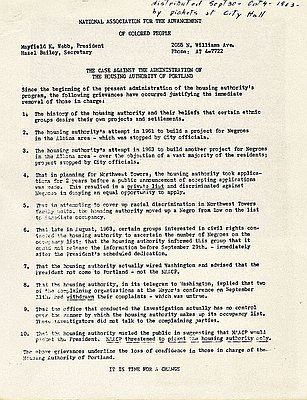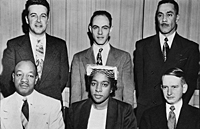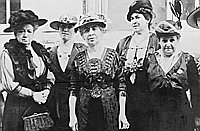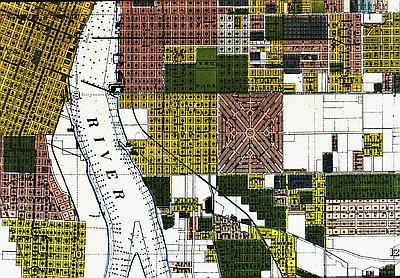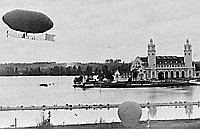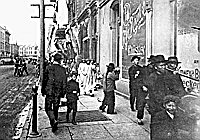Origins of a Civil Rights Movement
Just as the city’s commercial and entertainment foundations began to shift, so too did its population. The influx of war workers, including unprecedented number of Blacks, turned the white population’s indifference to a tiny minority into fear of a new “race problem.” The meaning of race relations shifted rapidly in Portland, as in Seattle, Oakland, and Los Angeles. What had been a cultural and legal resistance by white Americans to a feared invasion by Asians was superseded by the more familiar effort by white Americans to segregate and demean African Americans. As Richard Neuberger again noted, “Jittery police officers, untrained in race relations, shot at Negroes for mere misdemeanors, and for the first time Portland found itself clutched by racial tensions.”
African Americans had a long history of challenging denials of their civil rights. In Portland, the civil rights struggle was led by Dr. DeNorval Unthank, Edwin C. “Bill” Berry of the Urban League, several ministers, and members of the Sleeping Car Porter’s union. These leaders and their struggles would parallel the larger national struggle for access to public accommodations, private housing, a respite from police intimidation, and basic human rights.
Two lengthy articles in the Oregonian in June 1945 tried to dispel the fears of whites about an increased Black population. The author cited data from public housing authorities in Vancouver, Vanport, and Guild’s Lake, as well as an interview with the banker E.B. McNaughton, to demonstrate that an increase in African American residents neither corresponded to an increase in crime or a decrease in property value. The Urban League and Unthank, the only Black member of the City Club, urged Mayor Earl Riley to follow Seattle’s example by appointing an Inter-racial Committee. They also suggested the state create an equivalent of the federal Fair Employment Practices Commission, that the Board of Realtors find ways to accommodate Black families who would vacate public projects scheduled for demolition, and that newspapers and radio stations improve the image they presented of Black communities.
At first, neither the legislature nor the mayor responded. A board appointed by Mayor Riley to eliminate World War II temporary housing wanted to turn Vanport into an industrial area, but did not know what to do with its Black residents or those at Guild’s Lake. The deteriorating conditions for Blacks came to a head on May 30, 1948, when the Columbia River demolished the old railroad embankment at Vanport. The Vanport flood left perhaps sixteen persons dead and almost 19,000, including about 4,500 African Americans, without homes. Most had no option but to seek shelter in the Williams Avenue district, which exacerbated the perception that it was now a slum.
Despite the persistence of discrimination, momentum for civil rights legislation waned as the Black population declined. A report in 1957 for the City Club found that the Black population had shrunk from 18,000 in 1945 to only 11,000. In 1949 Mayor Dorothy Lee appointed the Mayor’s Committee on Inter-group Relations, which recommended that the city council pass a civil rights ordinance requiring public accommodations be open to all residents. In 1950 the Council created a City Commission on Inter-group Relations to hold hearings when charges of discrimination against city agencies were made.
The public accommodations ordinance, despite the support of dozens of local organizations, including teachers’ organizations and religious affiliations, failed to pass in November 1950. It was defeated primarily in districts in northeast Portland whose residents feared the migration of Blacks into their neighborhoods. In 1953, however, the Urban League and its supporters got the legislature to pass a law outlawing racial discrimination in public accommodations. Persons could file civil complaints from which they might collect monetary damages. According to a study by the City Club in 1957, Portland real estate brokers still “represent the biggest single obstacle to Negroes in their quest for equal housing opportunities.” Residential segregation and poor job opportunities “have created Negro slum ghettoes of the worst order right in the city of Portland.”
© William Toll, 2003. Updated and revised by OHP staff, 2014.
Sections
Related Historical Records
Albina Residents Picket the Portland Development Commission, 1973
Beginning in the 1960s, the City of Portland, with the cooperation of the Portland Development Commission (PDC) and Emanuel Hospital, began to lay the groundwork for redeveloping the …
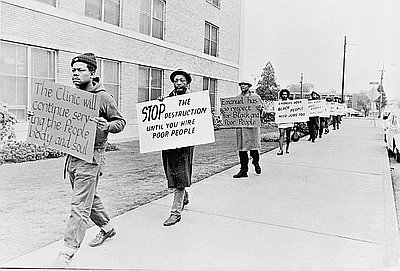
Albina Riot, 1967
What began as a political rally to stir the African American community to “revolution” in Irving Park on Sunday, July 30, 1967, turned into two-nights of disturbances. Two to …

NAACP Flier Protesting the Housing Authority
This flier was distributed by protesters of the National Association for the Advancement of Colored People (NAACP) on September 30 and October 4, 1963, at Portland’s City Hall …
